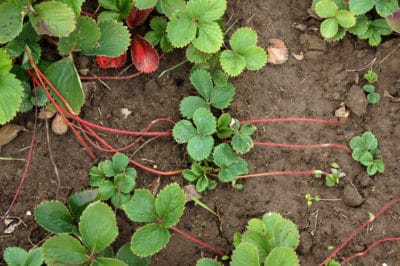How Strawberries Grow
Strawberries belong to a type of perennials known as stolonaceaous plants. Although unrelated, strawberries, Bermuda grass, stinging nettle and mugwort all spread by growing stolons, or runners. Each has the capability of growing a new plant at its tip, and the tips will usually root when they touch the ground. Eventually the mother plant dies and the patch spreads through the runners.
Selecting Varieties
Certain types of strawberries produce more runners. June-bearers are noted for prolific runner production, while everbearers don’t have as many. Any of these would be good choices for the home garden:
- Alpine strawberry
- Benton
- Brunswick
- Calypso
- Cabot
- Chandler
- Earliglow
- Honeoye
- Tristar
- Winona.
Matted Rows
Some gardeners take advantage of the strawberry’s tendency to produce runners by growing them in matted rows. These are basically wide beds. The gardener plants one or two rows of strawberries in the bed and the plants are allowed to produce runners until they fill in the beds. This technique allows for heavy production with minimal work transplanting new plants. The beds are renovated about every fourth or fifth year.
When to Plant Runners
June-bearing strawberries will fruit in early summer. As soon as they’re harvested, the plant begins to produce runners. These runners can be removed and replanted as soon as they develop roots. Everbearing strawberries will produce runners after their first flush of bloom in summer and then again in fall. Day-neutral strawberries are a type of everbearer and will follow a similar pattern.
Managing for Runner Production
Some people grow June bearers as an annual crop. As soon as the plants produce one crop, the gardener helps runners root by pegging them to the ground with wire staples. Once rooted, they are transplanted into pots or new beds. If you want to promote runner growth, make sure you give the plants plenty of nitrogen – it promotes leaf and runner growth.
When to Prune Runners
If you want the plants to focus on crown development and berry production, cut off runners as they appear. By the third year, most gardeners are ready to renew their strawberry beds. In the spring of year four, concentrate on establishing a new bed from the runners your plants produce; no more than five per plant. Use runners only from healthy, vigorous plants.
